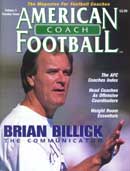Article CategoriesAFM Magazine
|
Be Careful How You Identify Defensesby: Homer SmithFormer offensive coordinator, Arizona, UCLA and Alabama © More from this issue Conventional names for defensive alignments—like Eagle G and Four Across—do not tell you what your plays will face. Certainly, computer analysis will not if it is done after inputting conventional names. What a given play will face is: (1) either a balanced or an unbalanced alignment, relative to your formation; (2) one defender who can keep himself free of pass routes, fakes, and blocks—an unoccupied defender, the counterpart of the offender who has the ball; (3) a degree of compression of defenders over your frontal blockers, which affects blocking angles; and (4) a reaction to the initial action of the play, which will determine where that unoccupied defender is relative to the ball. This article is about these four features of defenses. Balance or Unbalance Picture your formation. If you have one RB and he is behind the QB, a balanced defense will have either one or three defenders either on or very near the centerline. If you have two RBs behind, a balanced defense will have two or none; if no RBs, the same. The defense shown in Diagram 1 is balanced. The defense shown in Diagram 2 obviously is not. With a blink, after picturing that the defense must have either (a) three or one or (b) two or none, you can verify balance or detect unbalance. In the blink, if the defense is unbalanced, you can weigh the two sides and distinguish between heavy and light. Do defenses unbalance? Yes. From a hashmark, they will sometimes count the sideline as one-half of a man and go heavy to the field. Also, against unusual formations, they will make mistakes. You need to have plays that can be called at the LOS to get you to light sides. The Unoccupied Defender Diagrams 3 and 4 show the threats that an unoccupied defender can pose. Diagram 3 could be the best of all running formations—the two-deep safeties will stay back as long as there are pass threats to the deployed receivers. One of the safeties, above, will be the unoccupied defender against a run. Whereas, the alignment shown in Diagram 4 could be the worst for the run. The defender who will not be released on, faked, or blocked - the unoccupied defender - is near the ball. Best formation? Worst? It depends on where the unoccupied defender is, not upon how many linebackers and linemen there are or on how the defense is identified. The closer the unoccupied man is, the more important it is for (a) one offender to occupy two defenders, (b) blockers to reach toward a playside and the QB to fake toward the backside, or (c) the QB to be the ball—carrier. The Degree of Compression Compression is relative to the number of RBs. Look at six offensive linemen, against seven frontal defenders, with four different backfields. Obviously, the one arrangement of frontal defenders is not one problem for all four formations. Rather, it is four problems for four different degrees of compression relative to the frontal blockers. Giving one name to one arrangement is what misleads. It is best to identify defenses by the advantages and disadvantages that they present, especially in blocking angles, for the various plays. It is best not to identify them by pat names. In Diagram 9 &10, look at a tailback running on zone blocking out of two different formations. Out of one, the darkened defender must be occupied by a bootleg fake. Out of the other, the fullback can block that defender and, additionally, he can be a threat to break off the block and catch a pass before the QB can be stopped. Next, Diagram 11 &12, give a look at a short yardage defense from two different formations. From one, there is no place to run. To stop a handoff run, there are nine frontal defenders against seven frontal blockers. From another, there is a possible touchdown run. To stop an option, the defenders are not compressed enough. Two of the backside defenders need to get across the centerline, and they cannot. The Reaction to the Action Diagram 13 shows two inside DBs. Diagram 14 shows a zone-blocked slant, the DB on the playside reacts to become a tackler on the LOS. Diagram 15 is a hand-off draw, both inside DBs see the look of pass and react back, initially, to protect against post routes. The defense, which would commonly have a name, is different problems for different types of backfield actions. It depends on the reaction. Summary. Conventional names of defenses and computer analysis based on those names can keep you from focusing on what your plays are actually going to face. You do not have to name defensive alignments. You can simply talk of what the plays will face. How does it sound to talk that way? You say, for example, the formation in Diagram 16 is a zone-blocked belly play facing straightaway defenders. Or, Diagram 17 shows the play versus gapped defenders. Or, Diagram 18 shows the same play versus compressed defenders, where there is no way to gain a blocking advantage, even with a great QB fake. You do not equate the three defenses by identifying, with a name. Playing is the responsibility of players. Maneuvering for advantages is the responsibility of coaches. In talking about advantages, you do not want to be diverted by the way you name defenses. |
|
| HOME |
MAGAZINE |
SUBSCRIBE | ONLINE COLUMNISTS | COACHING VIDEOS |
Copyright 2024, AmericanFootballMonthly.com
All Rights Reserved




